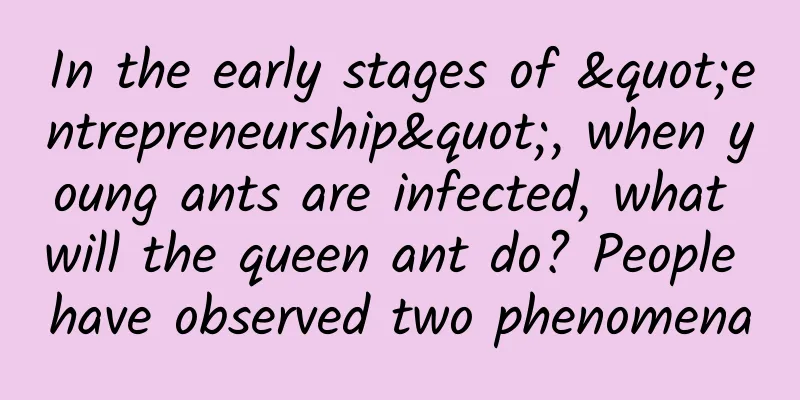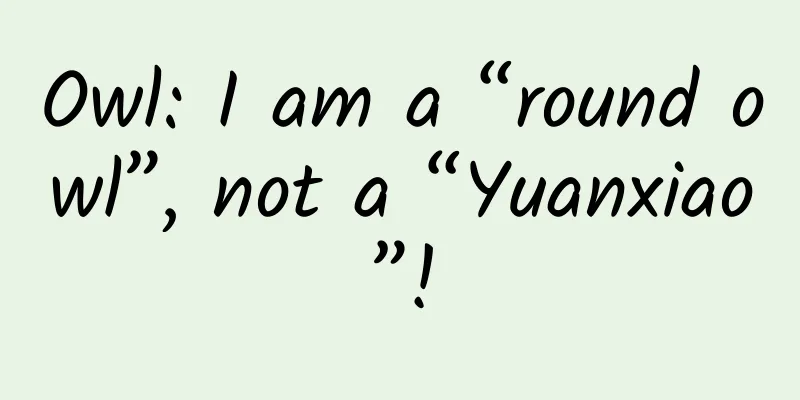In the early stages of "entrepreneurship", when young ants are infected, what will the queen ant do? People have observed two phenomena

|
Produced by: Science Popularization China Author: Earth's Gravity Producer: China Science Expo Editor's note: In order to decode the latest mysteries of life science, the China Science Popularization Frontier Science Project has launched a series of articles called "New Knowledge of Life" to interpret life phenomena and reveal biological mysteries from a unique perspective. Let us delve into the world of life and explore infinite possibilities. Ants are social insects that live together in groups and establish a clear social division of labor within the group. Generally speaking, ants are divided into: queen ants, worker ants, soldier ants, male ants, etc. The queen ant is responsible for production, the worker ants are responsible for collecting food and taking care of the queen and young ants, the soldier ants are responsible for defending the ant nest, and the male ants are only responsible for mating with the queen ant. This division of labor can sometimes be directly identified by the size of the ants. Workers of different ranks among leaf-cutter ants (7 on the left) and queen ants (2 on the right) (Image source: Wikipedia) But these are scenes that can only be seen in mature and large ant colonies. So, how do ant colonies start when they are first established? "You start as an ant, and you have to pick up all your equipment" When an ant colony is first established, it often goes through a very difficult start (similar to "starting with a dog and picking up all the equipment"): often a queen ant goes to a new area, and after a long process of settling, hunting, laying eggs, and hatching, the ants in the colony will slowly grow to a safe enough place. During this period, they may be killed by being preyed on, insufficient food collected, or infected by bacteria. Therefore, in general, the probability of an ant colony being able to successfully establish itself is still relatively low. Among these factors that lead to the complete destruction of ant colonies, infection by pathogens (especially infectious pathogens) is particularly important, because the early stages of infection are often difficult to detect, but by the late stages everything is too late. In mature ant colonies, because there are sufficient ants, they can often prevent the spread of pathogens in a variety of ways, such as: (i) Avoidance : Actively avoid contaminated areas, close the nest entrance, and refuse contaminated individuals from entering the nest; (ii) Active cleaning : Actively clean the germs in the nest by cleaning each other's bodies and moving dead individuals to an isolation area. However, in the newly born ant colonies, due to the limited "ant power" resources, the above conditions are often not met. Therefore, scientists are very curious about the epidemic prevention methods of this ant colony in its infancy. Recently, some scientists have conducted special observations and experiments. The young ants are infected, what should the queen ant do? Through observation and experiments, it was found that for the queen ant, the most effective way to prevent the disease is to eat infected young ants or ant eggs and reuse their nutrients to produce clean ant eggs. This experiment used black ants (Lasius niger) and green muscardine (Metarhizium). Among them, black ants are a type of ants distributed all over the world. There is only one queen in their ant colony. Around autumn every year, the queen ant will build a nest alone after her nuptial flight (usually digging a hole in the moist soil layer by herself). After digging, the queen ant will block the entrance and start laying eggs (the body size may decrease by 50% after laying eggs). The picture shows the queen of black-haired ants after her nuptial flight. She still has her wings. She will then eat her wings to try to accumulate more organic matter. (Image source: Wikipedia) It takes several weeks for the first batch of eggs to hatch and become the first worker ants. These workers are small but extremely critical. As soon as they are born, they will start looking for food for the queen. Once these workers die, the hungry queen will also meet her end. Green muscardine is a common fungus in the soil. It parasitizes on the surface of many insects. The hyphae that appear after the spores germinate will penetrate the insect surface and enter the insect body to develop. The insect will die within a few days after being infected. The dead insect's body surface will be covered with a layer of green spores. Since this fungus infects insects including termites, locusts and other pests, it is often used to make a biological pesticide for pest control. The dead body of a cockroach infected with Metarhizium anisopliae (Image source: Wikipedia) In the experimental group, the scientists first allowed the black ants to produce the first batch of larvae naturally. Then they extracted the strain from the black ants that were naturally infected with green muscardine and infected five of the larvae with the strain. After that, the larvae were isolated for 24 hours - this time was just enough for the strain to develop and become a deadly pathogen without being able to infect. Finally, the five infected larvae were returned to the ant nest to observe the queen ant's reaction. In the control group, five larvae were selected and subjected to the same operation except infection. After the larvae were placed back into the ant nest, the queen ant's reaction was also observed. It was observed that 92% of the queens in the experimental group chose to eat the infected larvae without leaving any residue, while only 6% of the queens in the control group ate the larvae. Since the control group showed that under normal circumstances, queen ants often eat the bodies of dead larvae to recycle nutrients, in order to determine whether the queen ants ate the larvae because the larvae were infected with the bacteria or simply because the larvae died, the scientists further provided the queen ants with: (1) infected larvae, (2) frozen uninfected larvae, and (3) uninfected normal larvae as a control group. The results showed that the infected larvae were eaten at a higher rate than the other two groups of larvae. Infected larvae are more likely to be eaten by the queen (Image source: Reference 2) Scientists believe that these queen ants may have some means of sensing whether the larvae are infected, similar to how humans measure body temperature to detect whether they are sick, but instead of relying on body temperature, the larvae may have some unique changes in their epidermis or produce certain compounds after being infected, and the queen ants use these changes to detect whether the larvae are infected. At the end of the experiment, the survival rate of the queen ants that ate the infected larvae was similar to that of the other two groups of queen ants, which shows that the queen ants' method of epidemic prevention is effective. Why doesn't the queen ant become infected after swallowing infected larvae? But why doesn't the queen ant become infected after swallowing the infected larvae? Theoretically, when eating infected larvae, the queen ants would also swallow the strain directly into their stomachs, causing the strain to grow directly in their bodies. Scientists speculate that this is because the queens may kill the strains in their bodies by ingesting their own acidic venom, because they have been observed combing their venom glands. To further understand why queen ants eat infected larvae, the scientists also simulated a situation in which the queens were unable to detect and eat infected larvae: they fed the queens larvae from the late infectious stage to the end of the infection stage, as well as control larvae. At the end of the infection stage, the fungus has consumed the nutrients in the larva and enters a stage of mass spore production, producing hundreds or thousands of tiny, new, infectious spore fruiting bodies. According to scientists' observations, queen ants will try to spray antibacterial venom on the bodies of larvae that are producing fruiting bodies, which is a very proactive epidemic prevention measure. However, if the queen ants are unable to eliminate the fruiting bodies after consuming the venom in their bodies, they will be infected with bacteria and die. In the experiment, about 80% of the queen ants died as a result, and even if a few queen ants survived, their larvae would be infected and die one after another. Research shows that the queen ant's "entrepreneurial" thinking is effective In further experiments, the scientists found that queen ants that ate the infected larvae laid 55% more eggs in subsequent egg laying than queens that did not eat the infected larvae. Therefore, scientists believe that this practice of "eating infected larvae" is not only effective in controlling infectious diseases, but also part of a survival strategy, because in the early stages of "entrepreneurship", every larva is crucial, and the number of worker ants they produce after hatching determines the amount of resources collected by the ant nest at the beginning - the more worker ants there are, the more food they collect, the more eggs they lay, and the more worker ants produced subsequently, and the higher the survival rate of the ant nest will naturally be. References: 1.Cremer S, Pull CD, Fürst M A. Social immunity: emergence and evolution of colony-level disease protection[J]. Annual Review of Entomology, 2018, 63(1): 105-123. 2.Bizzell F, Pull C D. Ant queens cannibalise infected brood to contain disease spread and recycle nutrients[J]. Current Biology, 2024, 34(18): R848-R849. |
<<: Ice and fire, Kilimanjaro on the equator is a snowy mountain and also a volcano!
Recommend
China Passenger Car Association: Analysis of the Pickup Truck Market in October 2022
According to data from the China Passenger Car As...
Soft and light... these shoes are comfortable but hurt your feet! Are the "shit-like" shoes really good?
This article was reviewed by Dr. Tao Ning, Associ...
Functional Animation in UX Design
[[149375]] A good UX designer can easily explain ...
How do post-00s use mobile Internet?
Baidu released the "2015 New Year's Edit...
Ocean Love Story Series | Ashi's Old Grave Together: Childhood sweethearts, living together till death
01 Holding hands with you, growing old together A...
Google Maps app update: COVID-19 reminders added to Android and iOS versions
Although the COVID-19 epidemic caused by the new ...
Android creator Andy Rubin: a genius envied by Steve Jobs
This year, China has been swept by an "Apple...
Baby thermos kettle turns into "toxic glue" kettle? Netizens smash kettle at home to verify
In the past two days, many parents on social medi...
Are humans the loneliest specks of dust in the universe? These romantic journeys in space exploration will tell you the answer
Whether you believe it or not, I firmly believe t...
Sailing east six times? This is Jianzhen's voyage eastward
Sailing east six times? This is Jianzhen's vo...
Baidu, Alibaba, Tencent, which of the three giants is the most dangerous?
As the three giants that monopolize domestic sear...
Kaola Global Shopping Product Analysis!
Cross-border e-commerce is a branch of the e-comm...
What does server rental mean? What is the difference between renting a server abroad and renting a server in China?
What is the difference between renting a server a...
Event operation and promotion | Large company event operation process and routines!
Activities are an effective means to drive rapid ...
Start with copywriting to quickly improve SMS conversion and experience
This article analyzes a variety of practical scen...









